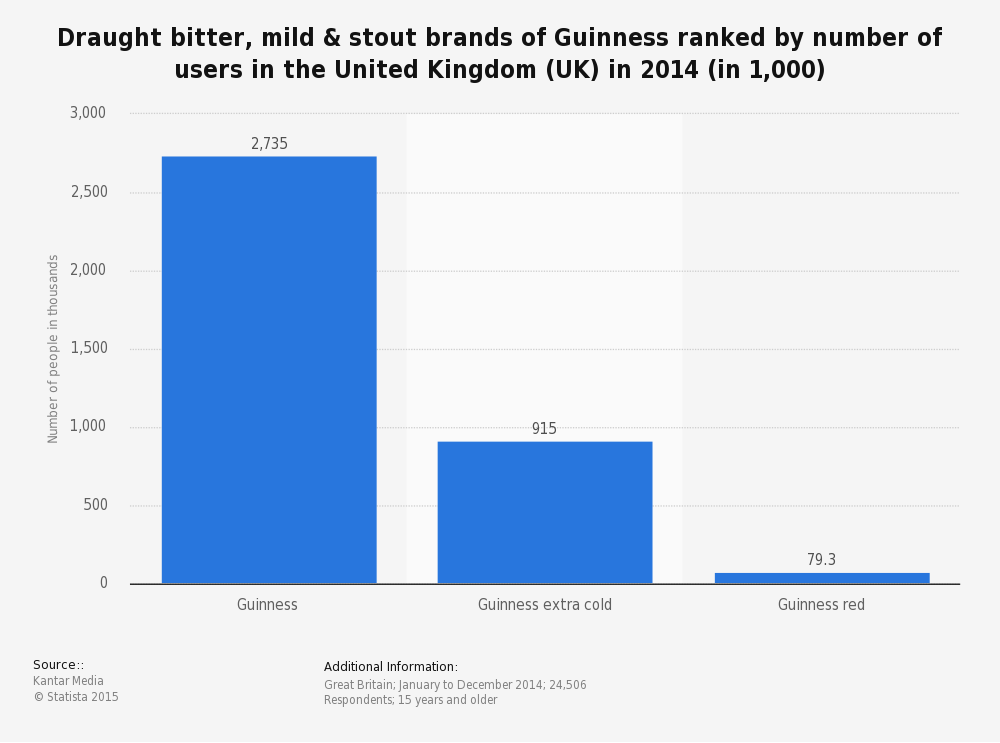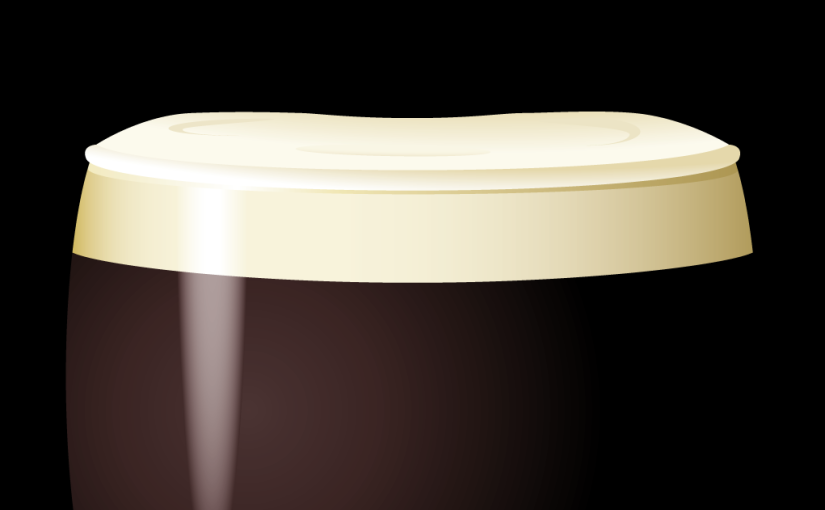Development and Quality
GUINNESS is what we know today as a “Stout”. In 1759 Ireland, It was originally brewed as “Porter” and later “Stout Porter” because it was popular with UK train porters. They preferred it for its strong taste. Arthur also brewed Ale when he first opened the brewery, but it was no longer produced by 1799. “Pure Beauty. Pure GUINNESS” is the slogan used to identify all styles of the beer.
The brewery currently produces the following types of GUINNESS:
- Guinness Original (canned or bottled): The original brew from 200+ years ago
- Draught Guinness (launched as draught beer in British pubs in 1959 and now in cans and bottles too): this contains nitrogen and carbon dioxide. The creaminess of the head is produced by the nitrogen as very fine bubbles and the method used to dispense the beer.
- Guinness Red (draught): lighter tasting draught stout – the barley is roasted a little less and the red colour comes out more.
- Foreign Extra Stout (bottled): most full-flavoured of all. brewed with extra hops. the flavour is bitter and sweet. Contains only the carbon dioxide which gives it a more acidic taste
This chart shows how some types of GUINNESS were ranked by number of users in the UK in 2014:
The newest development for the product was announced this November 2015. By the end of 2016, GUINNESS are removing one of the ingredients, Isinglass (from fish bladders), to make their products suitable for vegetarians and vegans. This is going to be possible because of a new filtration process to remove yeast particles.
Design and Description
GUINNESS is composed from water, hops, brewers yeast and barley malt. On first glance, the colour of the beer looks black. It is actually a ruby red when held up to the light, and this signature dark colour is a result of a portion of the barley being flaked (which involves steaming, rolling and roasting). The draught requires a signature double pour. It is dispensed through a five-hole disk restrictor plate or with a widget, supplying an uncommon amount of nitrogen. This produces the creamy head as mentioned before. To pour the perfect pint of GUINNESS takes 119.5 seconds.
GUINNESS is described as the Nation’s favourite drink. It is the quintessential Irish brew.
Packaging
Packaging has gone through various container changes and redesigns, but the trademark label was first introduced in 1862 and still remains – an oval label with the harp and Arthur Guinness’ signature. The harp was a registered trademark in 1876. As mentioned earlier, the beer started out in stoneware and was eventually packaged in glass bottles in 1834. It is also available on tap or in cans. Draught can come in a can because of the invention of the ‘widget beer’. Bottled draught beer is also possible because of the invention of the ‘rocket widget’. In ### GUINNESS revealed a new American style lager to release to the American market. The new lager’s packaging was more in keeping with branding of typical lagers of major corporate brewers in the U.S. The style is near-monochromatic as opposed to the more colourful and whimsical branding often seen on craft beer brands.
Uses
Guinness products are mainly used as drinks and much of the time during social occasions, but they have some alternative uses too. Guinness is sometimes used as an ingredient in recipes for starters, main courses and desserts. It is also used as an ingredient in cocktails. In 1861, the famous cocktail called the ‘black velvet’ was invented which is a 50/50 mix of GUINNESS and champagne. Recipes can be found throughout the internet. Visit the official site http://www.guinness.com/en-gb/food.html to see their listed recipes and cocktails.
Reputation
Guinness is seen all over the world as a potent national symbol of Ireland. It is known for its full-bodies flavour, dark colour and creamy texture and has a reputation as a “meal in a glass”. This is a misnomer since the beer actually has less alcohol and calories than other beers. It also has a reputation for being an older gentleman’s drink, though GUINNESS has tried to change this reputation in various global ad campaigns.
Strengths
One major strength of this product is that it is the only global stout brand available. Another strength is its ties with the Irish holiday, St. Patrick’s day. 13 million glasses are enjoyed round the world in that one day! A typical day would see 8 million glasses consumed. In general this link to Irish heritage has been a strength. The distinctive and unique flavour, colour and texture can be seen as a strength since there are no other brands that have matched this. Another helper are the scientific studies that say drinking beer in moderation is good for your health, and GUINNESS has a reputation for containing antioxidant compounds.
Weaknesses
As much as the flavour, colour and texture can be a strength, they can be a weakness too. Some people find this beer too heavy and filling and might go for something more crisp and fresh. Some consumers are also turning to craft beers over established brands since for craft beers, quality wins out over quantity. Another weakness is the trend of health conscious populations to shift from beer consumption to wine and spirits. Other scientific studies go the other direction and link beer drinking with increased risk of breast cancer as well as liver damage, other types of cancer and decreased brain function. Another threat is the role of alcohol in differing cultures. Some people choose not to drink alcohol at all.
The Product Sales Features
Exclusive
Sales features exclusive to GUINNESS products is a distinct dark creamy brew, the position as the only global stout available worldwide, it’s Irish heritage, the antioxidant compounds responsible for health benefits, and high iron content. Health benefits however are never used by GUINNESS or Diageo as selling points. The company never makes medical claims for their drinks and they even run advertisements calling for “responsible drinking”. Positioning the product as healthy would be contradicting to these points.
Nonexclusive differentiating qualities
Beer in general has a wide spectrum of vitamins and minerals. One study showed that the darker the beer, the more flavonoids it contains making GUINNESS better for reducing risk blot clots in the body. GUINNESS is one of the lower alcohol beers. It has an ABV of 4.0, which is less than the watery brews labelled “light”. Coors Light has 4.2, Bud Light has 4.2, and Corona Light has 4.5. Guinness Draught seems heavy, but it is actually one of the lowest-calorie, non-light beers there is. It has about 125 calories which is 44% less than other stouts.
Competitive position
The competitive position could be that GUINNESS has fewer calories for a full-bodied and full-flavored beer. It would not be appropriate to officially position the beer for scientific health benefit findings since there is also risk of alcoholism and studies also link drinking beer to cancer.
The Product Research
Technological breakthroughs and improvements planned
The beer ‘widget’ was invented by GUINNESS so that Draught beers can be brought home in a can.
Fish bladder will soon be removed from the recipe to target a new audience of vegetarians and vegans.
Innovation in craft beer production is helping to drive net sales for GUINNESS. A marketing and branding campaign known as “The Brewers Project at St James’s Gate” was created to give new Guinness beers a podium. The new beers are craft porters, a golden ale and a blonde American lager.
